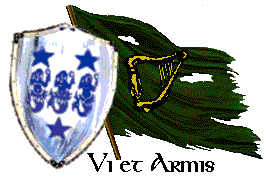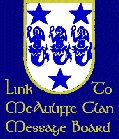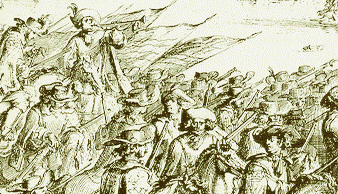
CONTENTS
Ancient Ireland
Clan Origins
Clan Lands
MacAuliffe Castles
Warrior Clan
Oppression
Loss of Lands
MacAuliffe in Exile
In Foreign Service
MacAuliffe Regiment
Coat of Arms
Historic Records
An Gorta Mor
McAuliffe Diaspora
Timeline
Famous MacAuliffes
Memorial
The Clan Today
Clan Rally
McAuliffe
Legends


ollowing the Treaty of Limerick in 1691, thousands of Irish soldiers left Ireland for Europe. France and Spain were at war with England and both countries eagerly recruited these tough soldiers who relished the opportunity to confront their old foe, England.
In 1709 King Phillip V of Spain commissioned the first permanent Irish regiments in the Spanish army. These regiments were headed by Dermot MacAuliffe and the Marquis of Castlebar. While thousands of Irishmen had served in Irish regiments in the Spanish army in preceding decades, the regiments had lacked continuity, being raised only for particular campaigns and then disbanded when that war was over.
"The Irish in 1710, signalized themselves in Spain, where Phillip V and his Austrian competitor, the Archduke Charles, were early in the field....
Among the royal regiments were two of Irish infantry, newly formed of deserters from the enemy, in Catalonia and Portugal. These regiments were commanded by Don Demetrio (Dermot) MacAuliffe and Colonel Don John de Comerford, the former the head or chief of the ancient sept of the MacAuliffes, of the barony of Duhallow, in the north-west of the County of Cork."
( O'Callaghan: "History of the Irish Brigades in the Service of France").
Dermot MacAuliffe became the first colonel of the new infantry regiment which was to become known as the MacAuliffe Regiment. The regiments of MacAuliffe, Comerford and MacDonnell combined to form the "Brigade of Irish Infantry of Castelar" which played a distinguished part in the Battle of Saragossa and later engagements. The commanders of these regiments earned distinction by placing themselves at the head of their forces to lead them into battle. In 1715 Teige (Don Tadeo) MacAuliffe suceeded Dermot as colonel of the MacAuliffe Regiment.
The regiment distinguished itself in numerous engagements including the Siege of Barcelona in 1710 and the capture of Palma, the capital of Majorca, in 1711. It took part in later engagements as part of Spain's war with England and Austria, including an attack on Sicily in 1718, in which the regiment's colonel, named only as Colonel MacAuliffe, was mortally wounded. D. H Allen speculates that this may have been Teige, or it could have been Michael MacAuliffe, the last reputed chief of the clann . Michael is said to have died in battle in 1720 while colonel of a regiment of the Spanish army, most likely the MacAuliffe Regiment, by then renamed the Ultonian Regiment. The change of name was made in 1718 when, by decree of the King, every unit of the Spanish army was to be given a permanent title. Thus the MacAuliffe Regiment became the Ultonian Regiment. As such it saw service in various parts of Europe and Spain's South American colonies over the next hundred years or more. Numbers of instances of the MacAuliffe name appear in Spanish military records for the period.
Of the MacAuliffe Regiment, D.H. Allen writes "To Irish minds the Regiment may not have attained the fame of Clare's Dragoons, or Dillon's, Burke's, or Mountcashel's Brigades; nevertheless during the Peninsular War in Spain, it covered itself with glory in the defence of Gerona against the veterans of Napoleon. In that engagement most of the Irish were killed, but the regiment survived, and annual tribute is paid to its founder (Dermot MacAuliffe) and to those exiles who served and died under its flag, in the troublesome days of the past.

<<< >>>


Stop the console and
click on a harp wher-
ever you see one to
play a different tune.
(not Netscape)
The opening tune is
"The Minstrel Boy'


Inexorably linked with Dermot MacAuliffe is the McAuliffe coat of arms which he registered in 1702. He was at the time the reigning chieftain of the clan. This was the same Dermot MacAuliffe who commanded the Irish defences at the Seige of Cork and was later to become the first colonel of the McAuliffe Regiment. Dermot initially fought in the service of France against England and its allies, but in 1709 moved to join the Spanish army. Registering the arms was probably necessary in order for him to become an officer in the European armies, signifying his nobility.
Armorial bearings had a practical purpose in war, providing a rallying point for soldiers to follow their commander in the confusion of the battlefield. Although the clan arms were never carried on Irish soil against the English oppressors, the ghosts of the McAuliffe dead must surely have rested more easily when, on numerous battlefields across Europe, Irish fighting men rallied behind the Arms of a McAuliffe chieftain to inflict punishment on the English forces facing them.
This page has been visited
times since
5 December1999
How fierce the smiles these exiles wear, who're
wont to look so gay;
The treasured wrongs of fifty years are in
their hearts today.
The treaty broken ere the ink wherewith 'twas
writ could dry,
Their plundered homes, their ruined shrines,
their women's parting cry,
Their priesthood hunted down like wolves,
their country overthrown!
Each looks as if revenge for all were staked
on him alone.





